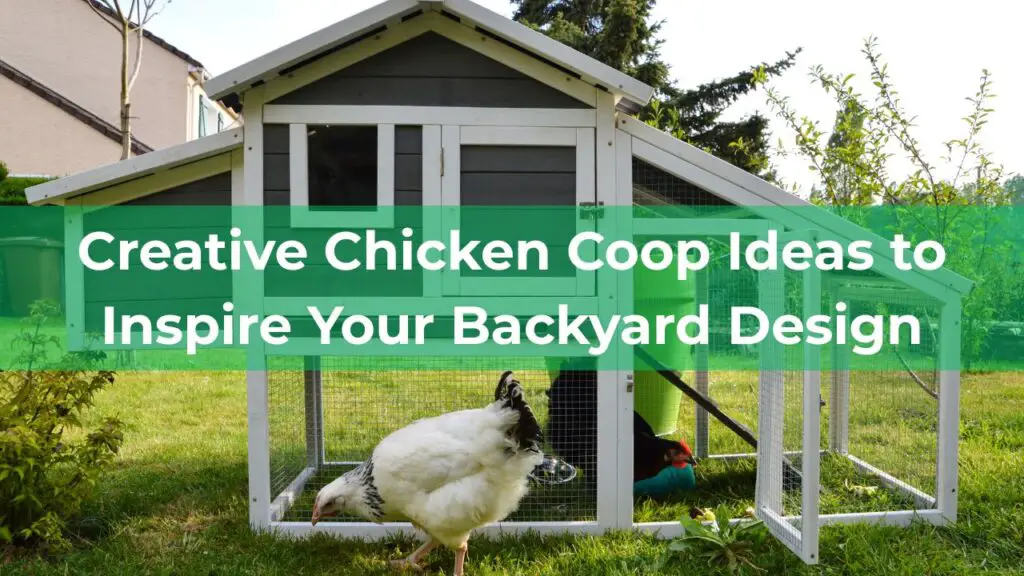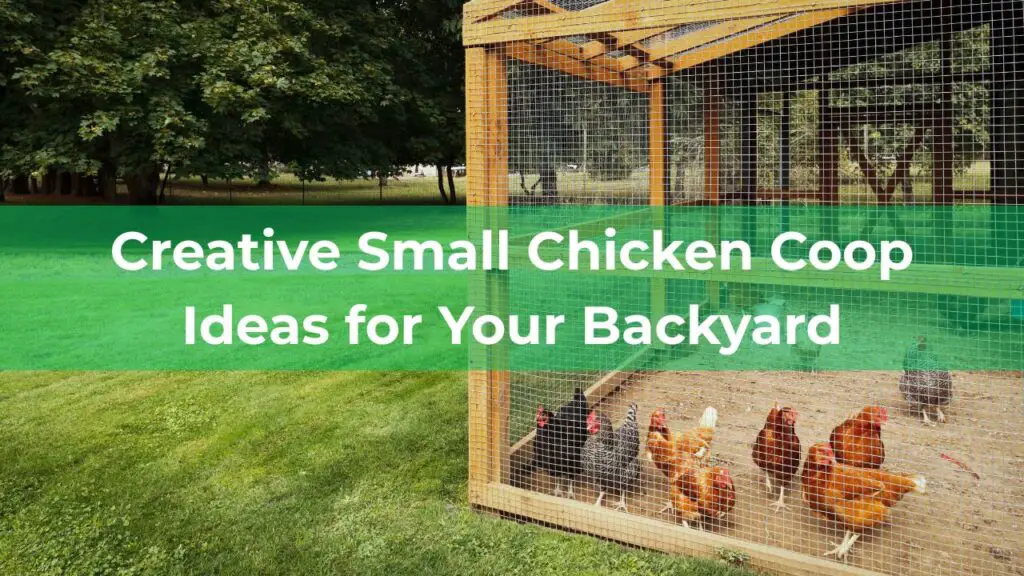Looking to spruce up your yard with some fresh veggie garden ideas? You’re in the right place! From vertical gardens to container planting, there’s a world of creativity waiting for you. Let’s jump straight into vibrant ways to grow vegetables, no matter how much space you have!
Raised Bed Gardening Benefits
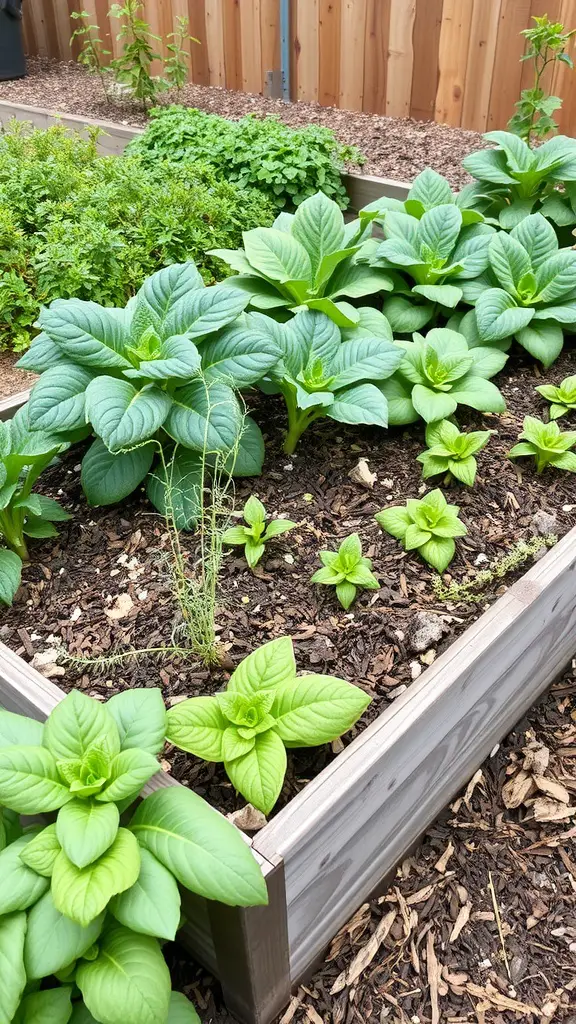
Raised bed gardening offers a fantastic way to grow your own veggies. The image shows a lush garden with vibrant green plants thriving in a wooden raised bed. This setup not only looks appealing but also provides numerous advantages for gardeners.
One major benefit is improved soil quality. You can control the soil mix, ensuring it’s rich in nutrients. This is especially helpful for growing healthy plants. The raised beds also provide better drainage, preventing water from pooling around the roots.
Another perk is easier access. With raised beds, you don’t have to bend down as much, making gardening more comfortable. This is great for those with back issues or anyone who prefers a more relaxed gardening experience.
Raised beds can also help keep pests away. The height makes it harder for some critters to reach your plants. Plus, you can easily add protective covers if needed. Overall, raised bed gardening is a smart choice for anyone looking to start a veggie garden.
Using Trellises for Climbing Vegetables
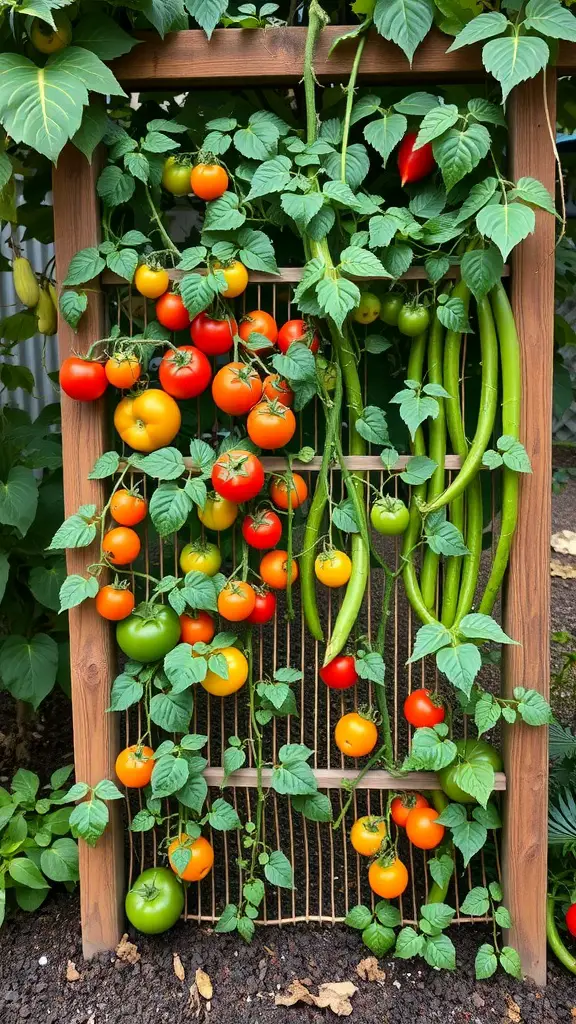
Trellises are a fantastic way to maximize space in your veggie garden. They allow climbing plants to grow upward, saving ground space for other crops. In the image, you can see a beautiful trellis supporting vibrant tomatoes and green beans. The colors pop against the greenery, making the garden look lively and inviting.
Using a trellis not only helps with space but also improves air circulation around the plants. This can lead to healthier growth and better yields. Plus, it makes harvesting easier! Just imagine reaching for those ripe tomatoes without bending down.
When choosing a trellis, consider the height and sturdiness. Some plants, like tomatoes, need a strong support system. Others, like cucumbers, can thrive on lighter structures. The right trellis can turn your garden into a stunning display of climbing vegetables.
Herb Spiral for Fresh Flavors
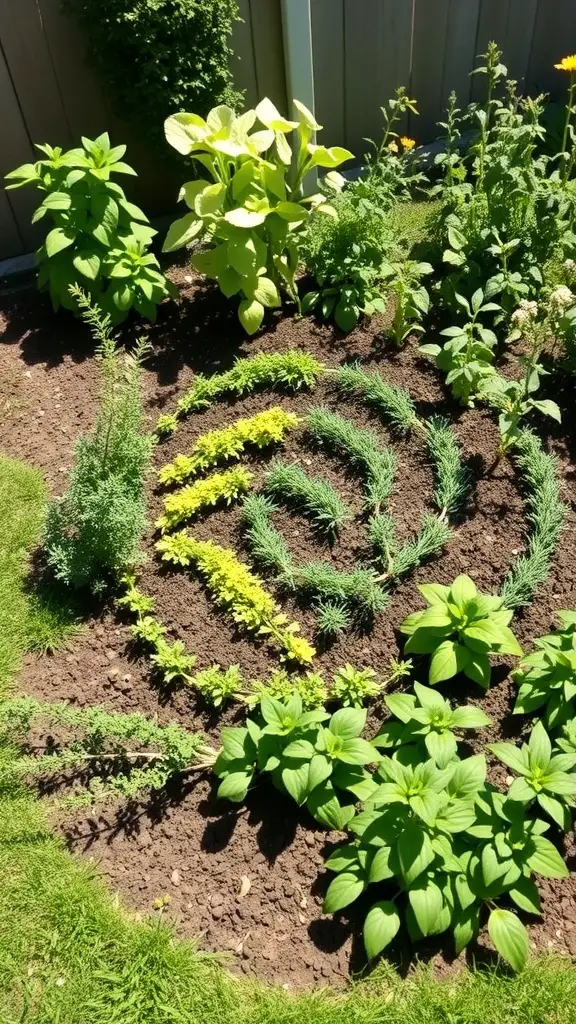
Creating an herb spiral is a fun and practical way to grow a variety of herbs in a small space. The image shows a beautifully arranged spiral garden, showcasing different herbs in a visually appealing manner. This design not only looks great but also maximizes sunlight and water efficiency.
The spiral shape allows for different microclimates, which means you can grow herbs that thrive in various conditions. For instance, the top of the spiral gets more sun and is perfect for sun-loving herbs like rosemary and thyme. Meanwhile, the lower parts can hold moisture better, making them ideal for herbs like mint and basil.
Planting herbs in a spiral is also a great way to keep them organized. You can easily identify each herb and access them when cooking. Plus, having fresh herbs on hand can elevate your meals, adding vibrant flavors to your dishes.
If you’re considering starting your own herb spiral, think about the herbs you use most often. Some popular choices include parsley, cilantro, and oregano. With a little planning and creativity, you can create a stunning herb garden that not only looks good but also provides fresh ingredients for your kitchen.
Succession Planting for Continuous Harvest
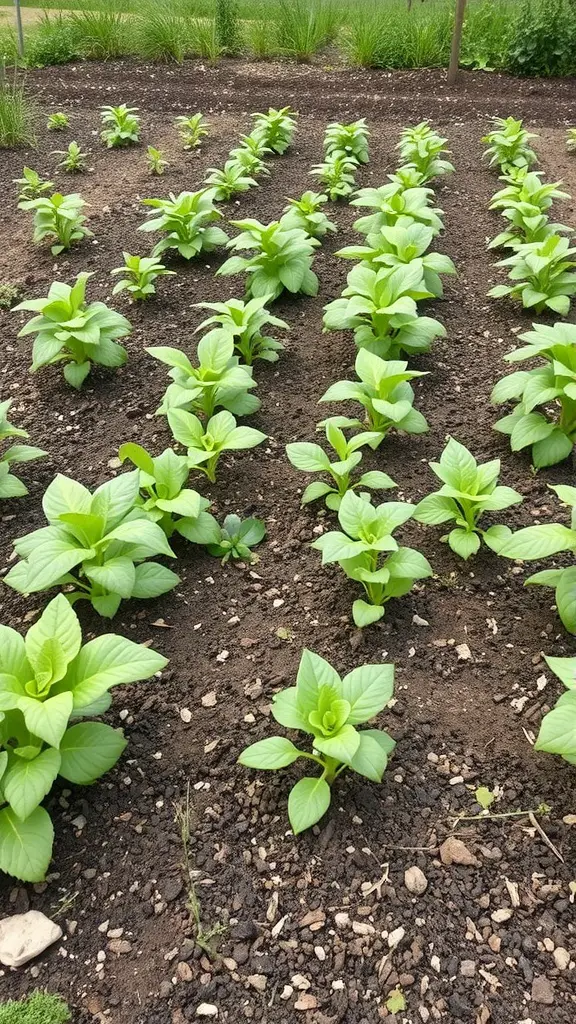
Succession planting is a smart way to keep your veggie garden thriving. The image shows rows of young plants, all at different stages of growth. This technique allows you to harvest fresh produce throughout the growing season.
By planting seeds or seedlings at regular intervals, you can enjoy a steady supply of vegetables. For example, if you plant lettuce every two weeks, you’ll have fresh greens ready to pick continuously. This method maximizes your garden space and keeps your meals fresh and exciting.
It’s also a great way to experiment with different varieties. You can try out new types of veggies or stick with your favorites. Just remember to keep track of your planting schedule, so you know when to expect each crop to be ready for harvest.
Companion Planting Strategies
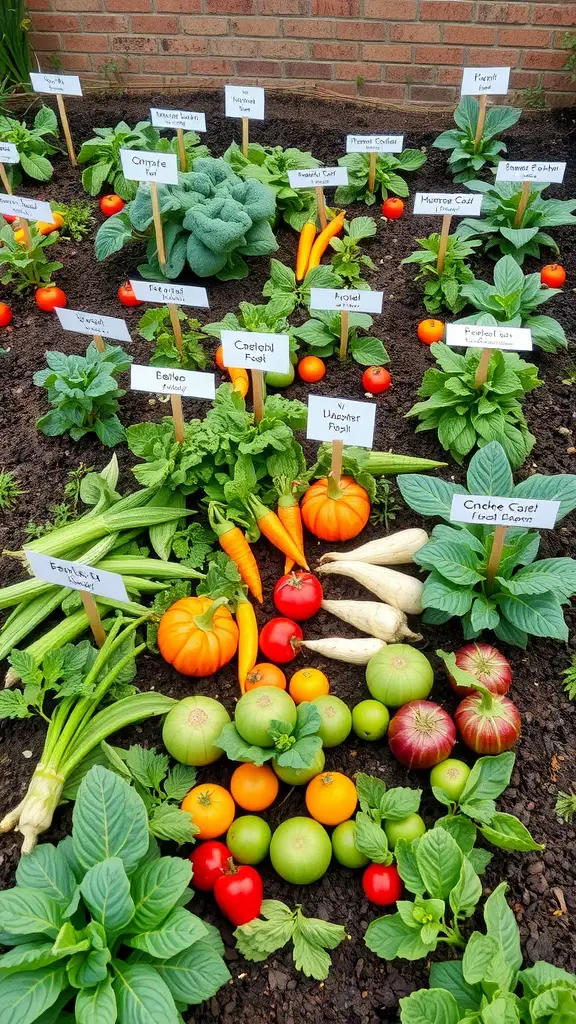
Companion planting is a fantastic way to boost your veggie garden’s health and productivity. In the image, you can see a vibrant garden filled with various vegetables, each labeled for easy identification. This setup not only looks appealing but also serves a practical purpose.
For example, certain plants can help each other grow better. Tomatoes thrive when planted with basil, as basil can repel pests that bother tomatoes. Similarly, carrots and onions make great companions, as they can deter each other’s pests.
When planning your garden, think about how different plants can work together. The colorful array of vegetables in the image shows how diversity can create a thriving ecosystem. Mixing plants can lead to healthier growth and a more bountiful harvest.
Don’t forget to consider the space each plant needs. Some veggies, like squash, can spread out, while others, like lettuce, can be planted closer together. This thoughtful arrangement can maximize your garden’s potential.
Creating a Pollinator-Friendly Garden
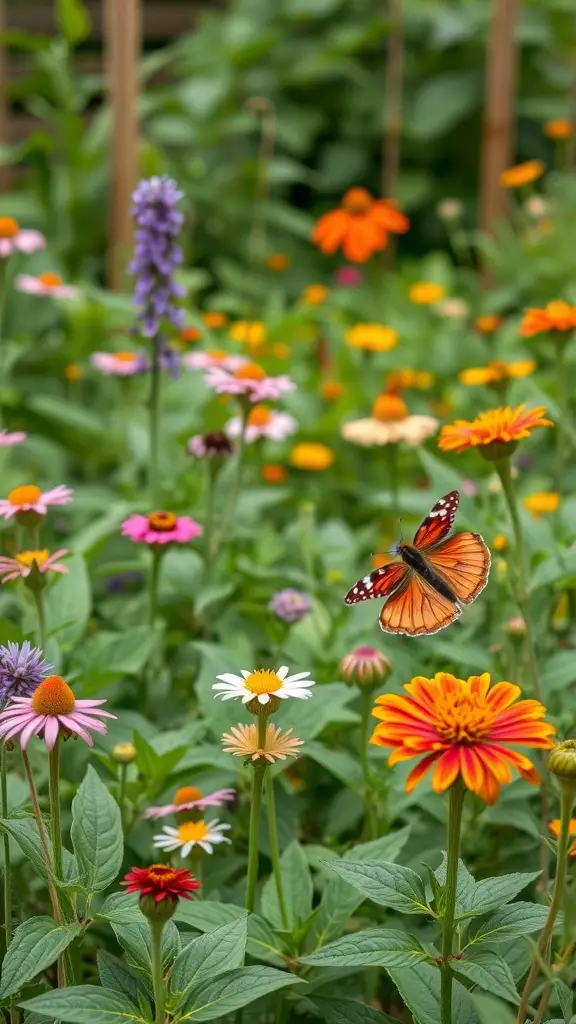
Creating a pollinator-friendly garden is a fantastic way to support local wildlife while enjoying the beauty of nature. In the image, you can see a vibrant mix of flowers attracting butterflies and other pollinators. The colorful blooms not only add charm to your garden but also provide essential food sources for these important creatures.
To start, choose a variety of native plants that bloom at different times throughout the season. This ensures that there’s always something for pollinators to feast on. Flowers like zinnias, coneflowers, and asters are great options. They come in various colors and shapes, making your garden visually appealing while serving a purpose.
Don’t forget to include some herbs like lavender and mint, which are also favorites among bees and butterflies. Creating small patches of these plants can encourage pollinators to visit more often. Plus, you’ll get the added benefit of fresh herbs for your kitchen!
Water sources are also important. A shallow dish with pebbles and water can provide a safe drinking spot for butterflies and bees. Just make sure to change the water regularly to keep it fresh. With a little planning and care, your garden can become a lively habitat for pollinators, enhancing both your outdoor space and the local ecosystem.
Vertical Gardening for Small Spaces
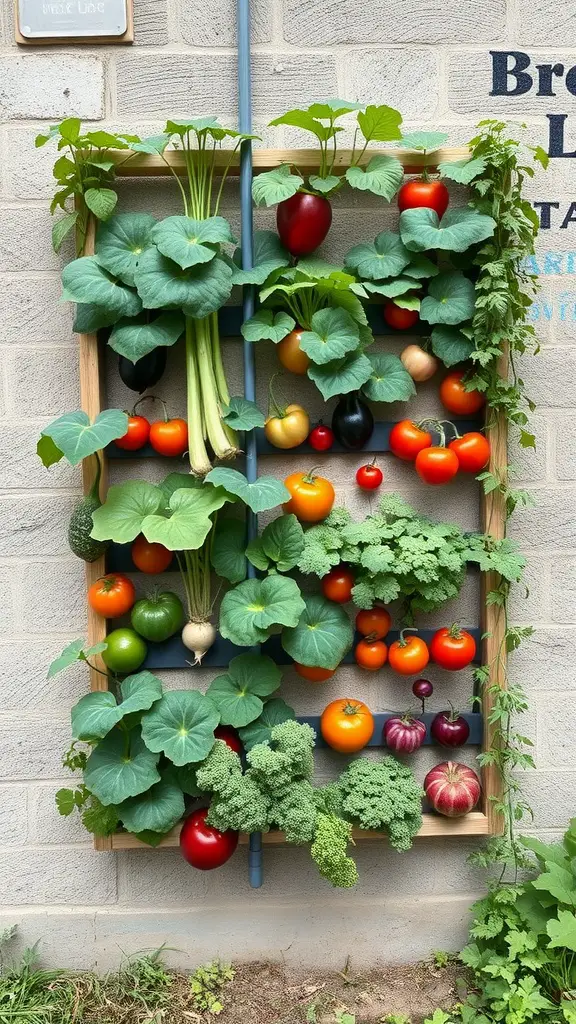
Vertical gardening is a fantastic way to maximize your space while growing a variety of vegetables. The image shows a vibrant vertical garden, filled with colorful produce. This setup allows you to cultivate different plants without needing a large area.
In this garden, you can spot a mix of tomatoes, peppers, and leafy greens, all thriving in a compact structure. Using vertical space not only saves room but also adds a beautiful visual element to your outdoor area.
These vertical planters are easy to maintain and can be placed against walls or fences. They make gardening accessible even in small backyards or balconies. Plus, the convenience of picking fresh veggies right from your garden is a rewarding experience.
Consider incorporating vertical gardening into your space. It’s a fun and practical way to enjoy homegrown produce while keeping your garden organized and appealing.
Container Gardening Techniques
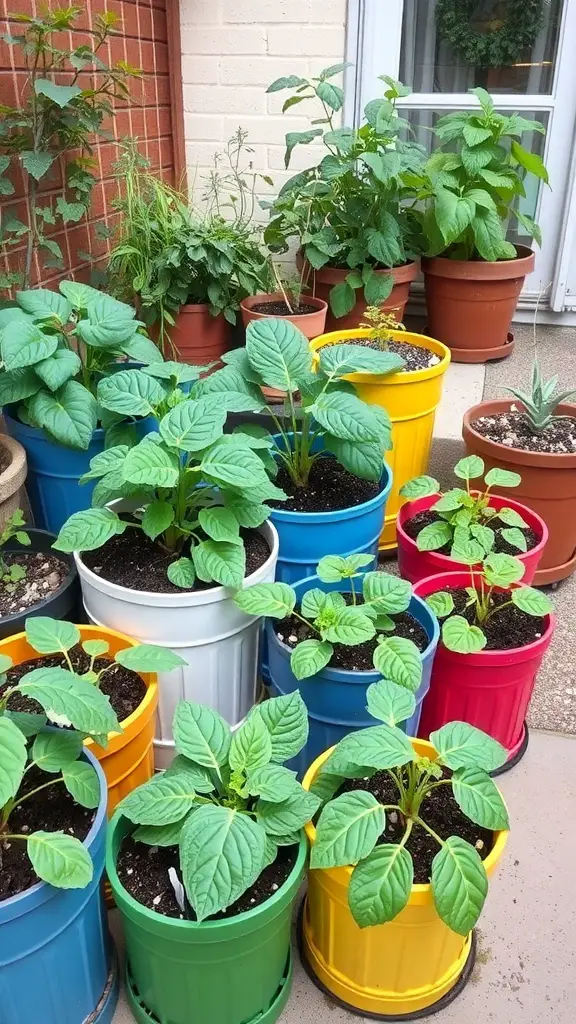
Container gardening is a fantastic way to grow your veggies, especially if space is limited. In the image, you can see a vibrant display of various plants in colorful pots. Each container is filled with rich soil, providing a cozy home for the plants to thrive.
Using different sizes and colors of pots not only adds visual interest but also allows you to customize your garden based on the needs of each plant. For instance, larger pots can hold bigger plants, while smaller ones are perfect for herbs or smaller vegetables.
Drainage is key in container gardening. Make sure your pots have holes at the bottom to prevent water from pooling, which can harm the roots. You can also add a layer of gravel at the bottom for extra drainage.
Don’t forget about sunlight! Most vegetables need at least six hours of sunlight a day. Position your containers in a spot that gets plenty of light, or consider moving them around to find the best location.
Watering is another important aspect. Containers dry out faster than garden beds, so check the soil regularly. A good rule of thumb is to water when the top inch of soil feels dry.
With a little creativity and care, container gardening can be a rewarding way to enjoy fresh veggies right at home!
Utilizing Kitchen Scraps for Regrowth
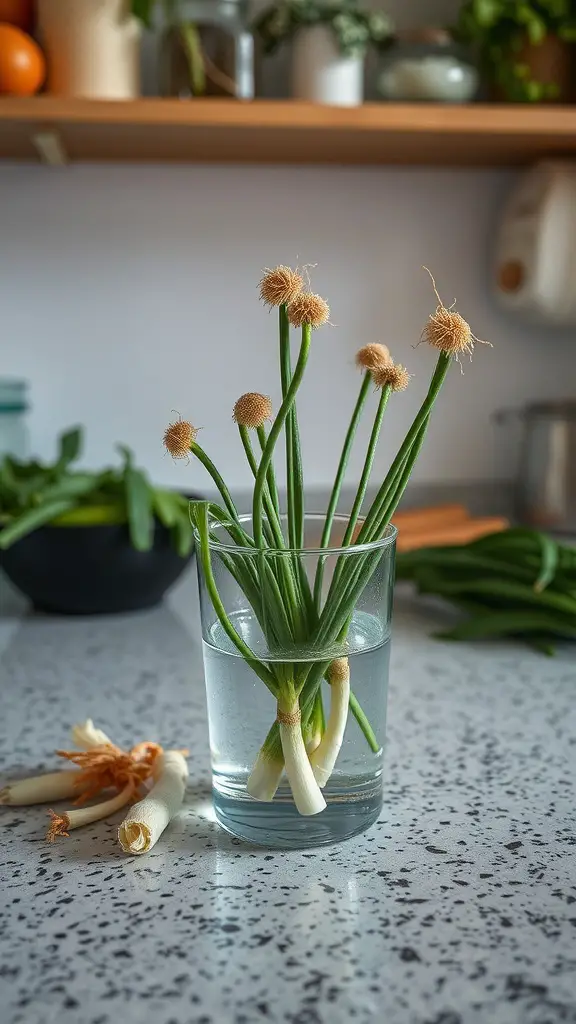
Using kitchen scraps for regrowth is a fun and practical way to keep your veggie garden thriving. The image shows green onions sprouting in a glass of water, a simple yet effective method to regrow this flavorful ingredient.
To start, just take the white roots of green onions and place them in a glass with enough water to cover the roots. Leave the glass on a sunny windowsill. In a few days, you’ll notice fresh green shoots emerging, ready to be snipped and added to your meals.
This method not only saves money but also reduces waste. You can do this with other veggies too, like celery, lettuce, and herbs. Just remember to change the water every few days to keep things fresh!
Soil Health and Nutrient Management
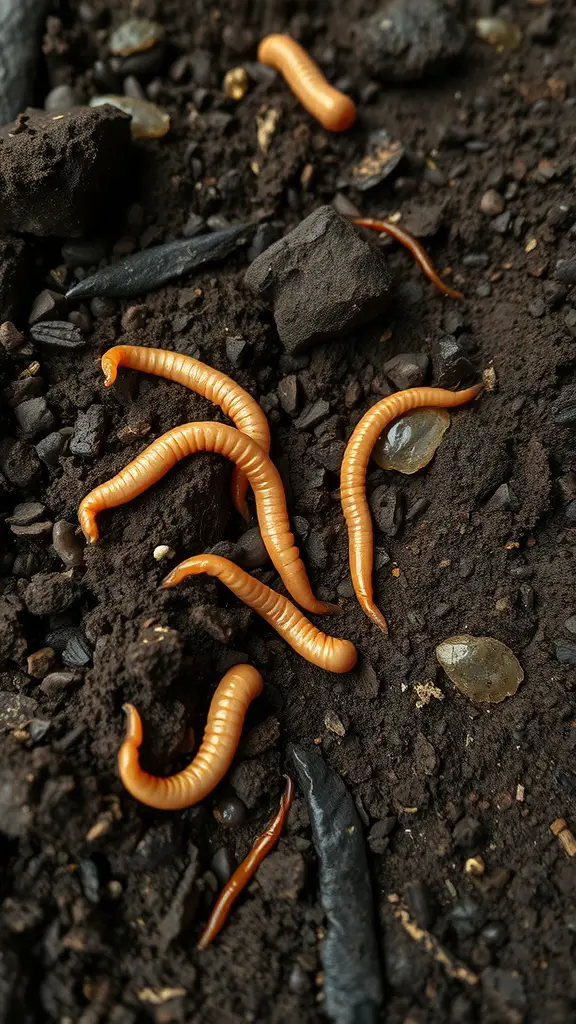
Healthy soil is the backbone of any veggie garden. The image shows some beneficial organisms, like worms, that play a key role in maintaining soil health. These little guys help aerate the soil and break down organic matter, turning it into nutrients that plants can use.
To keep your soil in top shape, consider testing its pH and nutrient levels. This helps you know what your soil needs. Adding compost can boost nutrient content and improve soil structure. It’s a simple way to give your plants a great start.
Don’t forget about crop rotation! Changing what you plant in each spot each season helps prevent nutrient depletion and keeps pests at bay. Mixing in cover crops during the off-season can also enrich the soil.
Seasonal Vegetable Planting Calendar
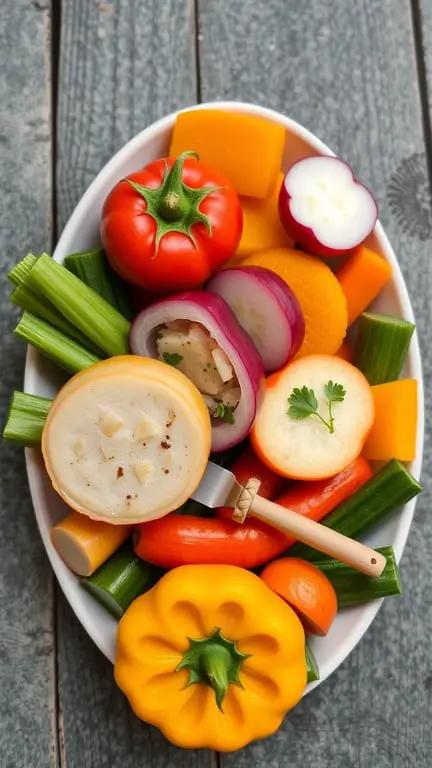
Planning a veggie garden can be a fun and rewarding experience. The seasonal vegetable planting calendar is a handy tool to help you decide what to plant and when. This calendar shows various vegetables along with their ideal planting days, making it easier to organize your garden.
In the image, you can see a colorful chart featuring different vegetables like carrots, tomatoes, and pumpkins. Each vegetable is paired with specific dates, guiding you on when to sow seeds or transplant seedlings. This visual aid simplifies the gardening process and helps ensure a bountiful harvest.
Understanding the timing for planting is key. For instance, some veggies thrive in cooler months, while others prefer warmer weather. By following this calendar, you can maximize your garden’s potential and enjoy fresh produce throughout the seasons. Whether you’re a seasoned gardener or just starting, this calendar is a great resource to keep handy.
Mulching Techniques for Weed Control
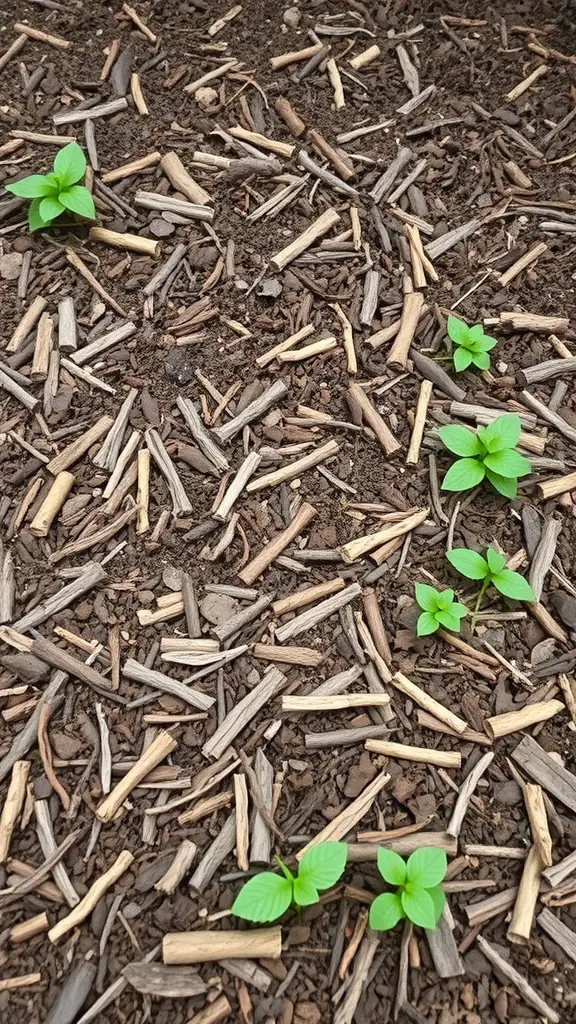
Mulching is a fantastic way to keep your veggie garden thriving while controlling those pesky weeds. In the image, you can see young plants peeking through a layer of mulch. This setup not only looks neat but also serves a purpose.
The mulch acts as a barrier, preventing sunlight from reaching weed seeds. This means fewer weeds competing for nutrients and water. Plus, it helps retain moisture in the soil, which is great for your plants.
Using organic materials like wood chips or straw, as shown in the image, can enrich the soil as they break down. This adds nutrients back into the ground, giving your plants a boost. Just be sure to keep the mulch a few inches away from the plant stems to avoid rot.
Overall, mulching is a simple yet effective technique to keep your veggie garden healthy and weed-free. So grab your mulch and get started!
Season Extenders for Year-Round Gardening
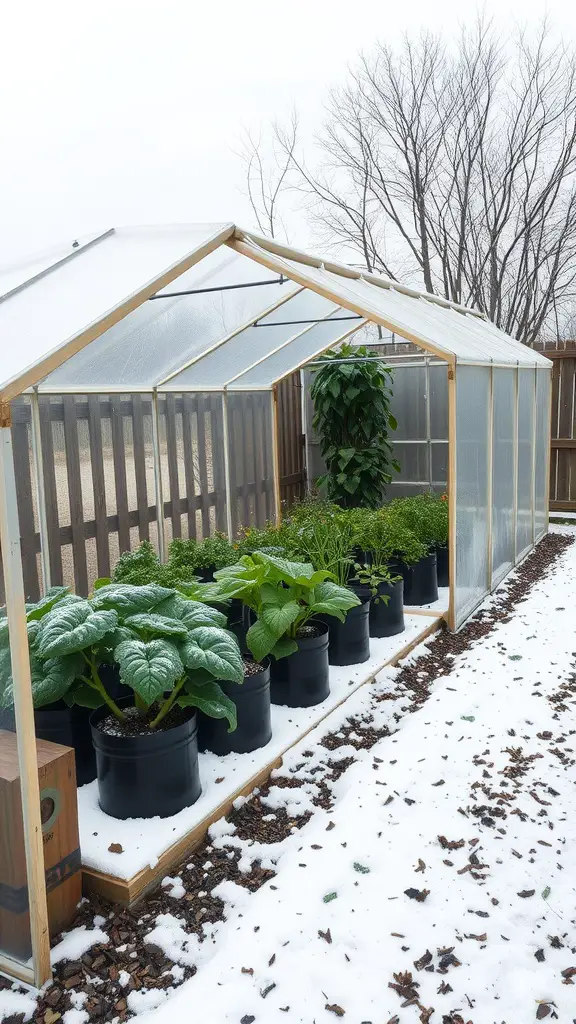
Imagine stepping into a cozy greenhouse, even in the chill of winter. This image shows a well-organized greenhouse filled with vibrant plants, all thriving despite the snowy backdrop. The structure provides a warm haven for your veggies, allowing you to enjoy fresh produce year-round.
Using a greenhouse is one of the best ways to extend your gardening season. It protects plants from harsh weather and pests while providing a controlled environment. You can grow everything from leafy greens to herbs, ensuring your garden remains productive even when outdoor conditions aren’t ideal.
In this setup, you can see various plants in pots, neatly arranged to maximize space. The snow outside highlights the importance of such a structure. With proper care, these plants can flourish, giving you a taste of summer even in the cold months.
Consider adding heating elements or using thermal mass to keep the temperature stable. This way, you can grow your favorite veggies and herbs all year long. A greenhouse not only enhances your gardening experience but also brings a touch of nature into your home, no matter the season.
Creating a Children’s Veggie Garden
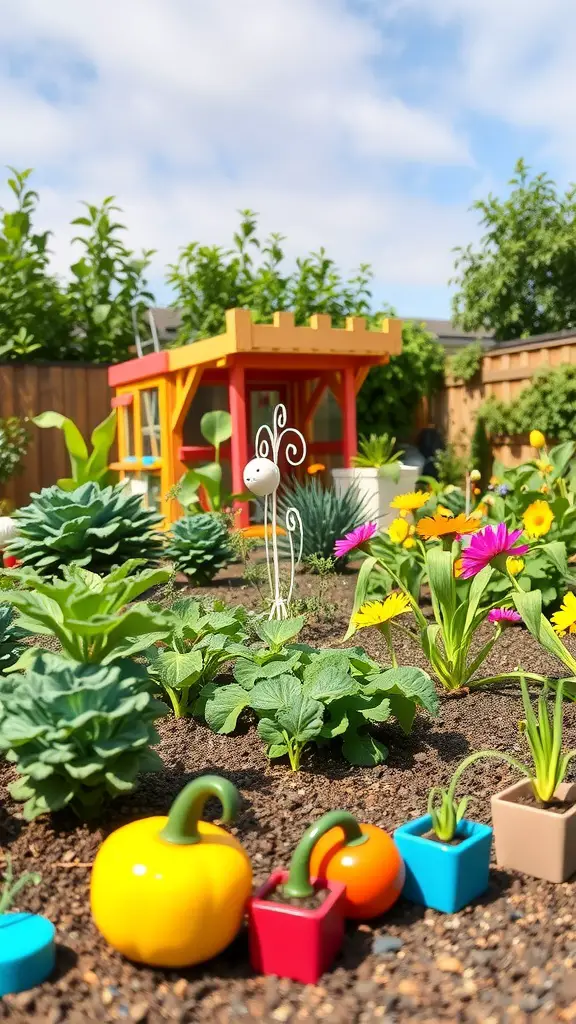
Creating a veggie garden for kids is a fun way to teach them about nature and healthy eating. The image shows a colorful garden filled with vibrant flowers and playful decorations. A small playhouse adds charm, making it an inviting space for children.
Start by choosing easy-to-grow vegetables like carrots, radishes, and lettuce. These plants sprout quickly, keeping kids engaged. Use small pots for seedlings, which makes it easy for little hands to manage. The bright colors in the garden, like the yellow bell pepper and cheerful flower beds, make gardening exciting.
Involve kids in every step, from planting seeds to watering the plants. This hands-on experience helps them learn responsibility. They’ll feel proud when they see their plants grow. Plus, harvesting veggies together can be a delightful family activity.
Creating a children’s veggie garden is not just about growing food; it’s about fostering a love for gardening and nature. With a little creativity and care, you can turn any backyard into a magical garden space.
Incorporating Native Plants in Your Garden

Native plants are a fantastic addition to any veggie garden. They not only thrive in your local climate but also support local wildlife. In the image, you can see a vibrant mix of native flowers and plants. The tall grasses and colorful blooms create a lively atmosphere, perfect for attracting pollinators.
Using native plants can help reduce maintenance. They are adapted to the local soil and weather, which means they often require less water and fewer chemicals. This makes them a smart choice for eco-friendly gardening.
Consider mixing native plants with your vegetable garden. They can provide natural pest control and improve soil health. Plus, they add beauty and diversity to your space. Imagine harvesting fresh veggies surrounded by colorful native flowers!
DIY Garden Structures for Support
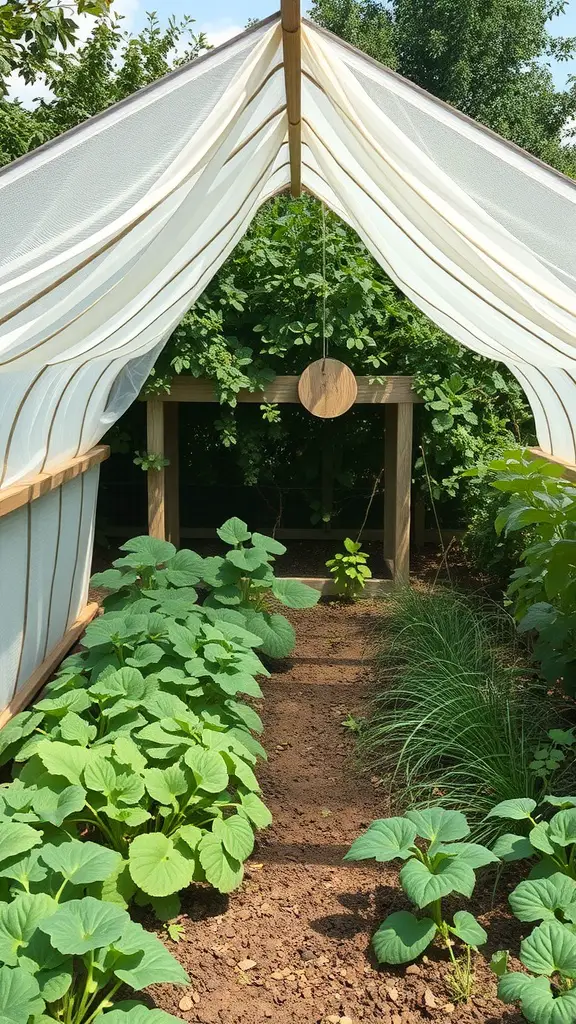
Creating a veggie garden can be a fun and rewarding project. One great way to enhance your garden is by building DIY structures for support. These structures help plants grow tall and strong, ensuring they get the sunlight and air they need.
The image shows a lovely garden setup with a simple yet effective structure. The frame is covered with a light fabric, providing shade while allowing sunlight to filter through. This design is perfect for protecting delicate plants from harsh weather while still promoting healthy growth.
Along the path, you can see vibrant green leaves of various plants. These leafy greens thrive in the well-structured environment, making it easier for gardeners to tend to them. Having a defined space helps keep plants organized and can even make harvesting easier.
Building your own structures doesn’t have to be complicated. With some wood, fabric, and a little creativity, you can create a cozy space for your veggies to flourish. Whether you’re growing squash, tomatoes, or herbs, a supportive structure can make a big difference in your garden’s success.
Edible Landscaping Ideas
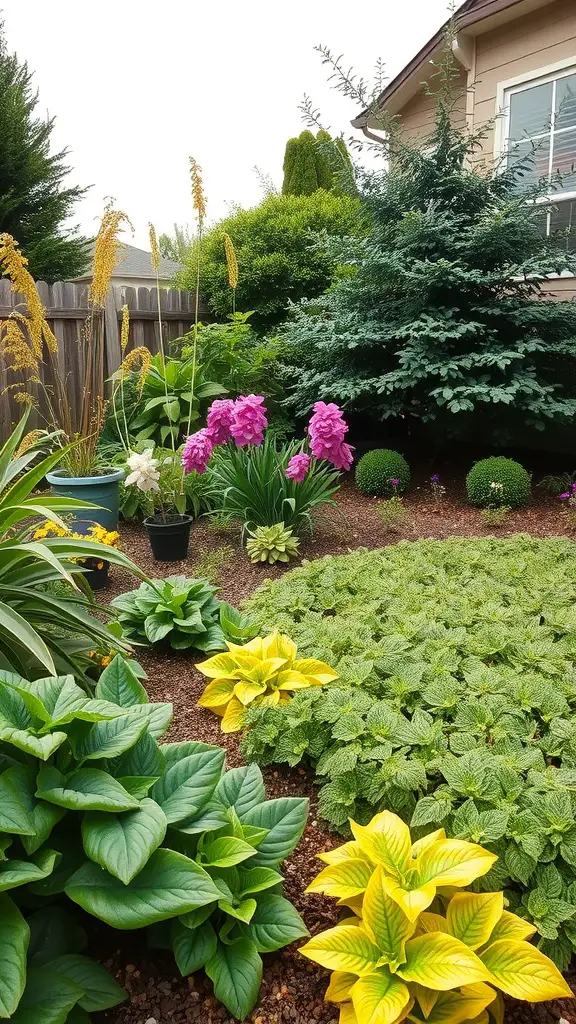
Creating an edible landscape can be a fun and rewarding project. Imagine a garden that not only looks beautiful but also provides fresh ingredients for your meals. The image shows a vibrant garden filled with various plants, showcasing how you can mix aesthetics with functionality.
In this garden, you can see a mix of colorful flowers and lush greenery. The bright yellow leaves stand out, adding a cheerful touch. Incorporating edible plants like herbs or vegetables among ornamental plants can create a stunning visual effect. For example, consider planting basil or chives near your flowers. This not only enhances the beauty of the space but also makes it practical.
Another idea is to use vertical gardening techniques. You can grow climbing plants like peas or beans on trellises. This saves space and adds height to your garden. Plus, it’s a great way to keep your garden organized and easy to maintain.
Don’t forget about the layout! Mixing different textures and colors can make your garden pop. Use a combination of leafy greens, colorful flowers, and even some fruit-bearing plants. This variety will keep your garden interesting throughout the seasons.
Using Cover Crops for Soil Fertility
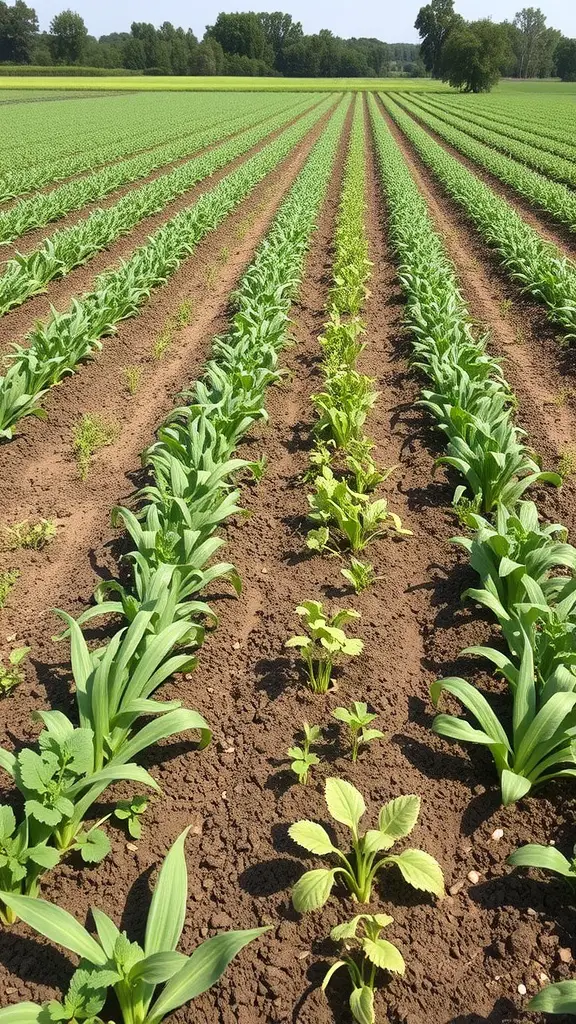
Cover crops are a great way to boost soil fertility in your veggie garden. The image shows a well-maintained garden with rows of healthy plants. These plants not only look good but also play a vital role in enriching the soil.
When you plant cover crops, they help prevent soil erosion and improve soil structure. The roots of these plants dig deep into the ground, allowing air and water to penetrate better. This is essential for growing healthy vegetables.
In the picture, you can see a variety of plants growing in neat rows. This method of planting helps in maximizing space while ensuring that the soil remains fertile. Using cover crops can also suppress weeds, making it easier to manage your garden.
As the cover crops grow, they absorb nutrients from the soil. When you till them back into the ground, these nutrients are released, providing a natural fertilizer for your veggie garden. This cycle keeps your garden thriving season after season.
Watering Systems for Efficient Irrigation
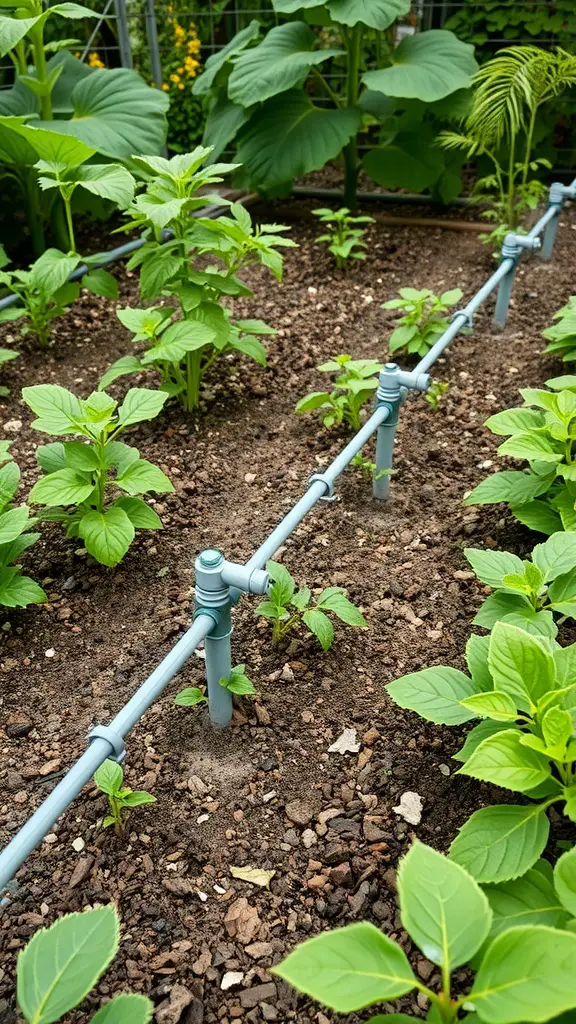
In a veggie garden, keeping your plants hydrated is key to their growth. The image shows a well-organized irrigation system using pipes to deliver water directly to the roots of the plants. This method is efficient and helps conserve water.
The setup features a network of pipes that distribute water evenly across the garden bed. This ensures that each plant receives the moisture it needs without overwatering. Such systems can save time and effort, allowing you to focus on other gardening tasks.
Using a drip irrigation system, like the one in the image, minimizes water waste. It delivers water slowly and directly to the soil, which is especially beneficial for young plants. This method also reduces the risk of fungal diseases that can occur with overhead watering.
Overall, investing in a good watering system can make a big difference in the health and productivity of your veggie garden. It’s a smart choice for anyone looking to grow fresh produce efficiently.
Crop Rotation Practices for Soil Health
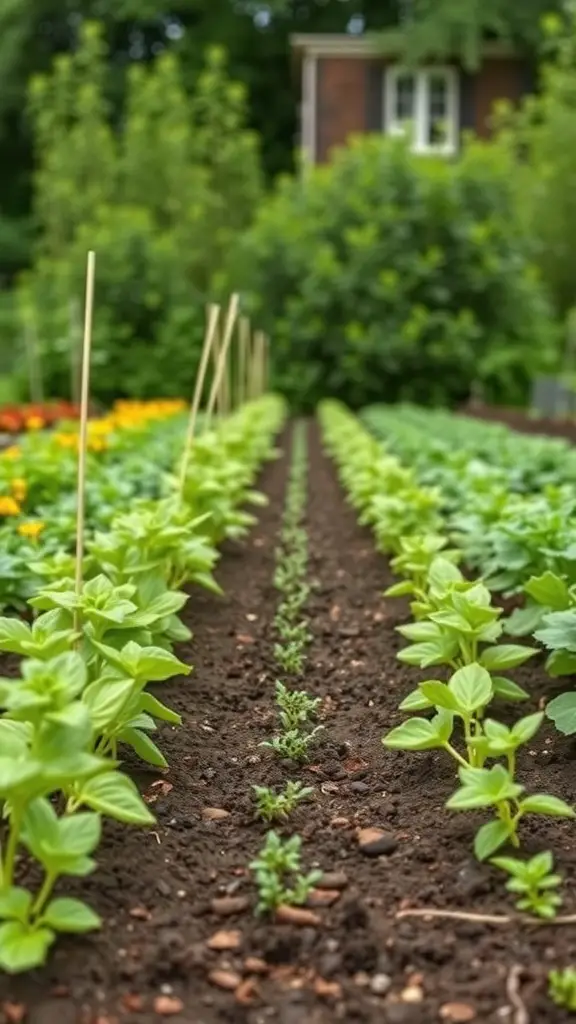
Crop rotation is a smart practice for keeping your veggie garden thriving. The image shows neat rows of plants, hinting at a well-planned garden layout. Each type of plant benefits from being in different spots each year, which helps maintain soil health.
When you rotate crops, you reduce the risk of pests and diseases that can build up in the soil. For instance, legumes like beans can add nitrogen back into the soil, making it richer for the next crop. This is a simple way to keep your garden productive without relying on chemical fertilizers.
Another benefit of crop rotation is that it encourages biodiversity. Different plants attract various beneficial insects, which can help with pollination and pest control. The vibrant greens in the image suggest a healthy mix of plants, which is key to a balanced ecosystem in your garden.
To get started, plan your garden layout for the season. Decide which crops will go where, and keep track of their locations. This way, you can easily rotate them in the following years. Remember, healthy soil leads to healthy plants, and crop rotation is a fun way to achieve that!
Creating a Shade Garden for Cool-Weather Veggies
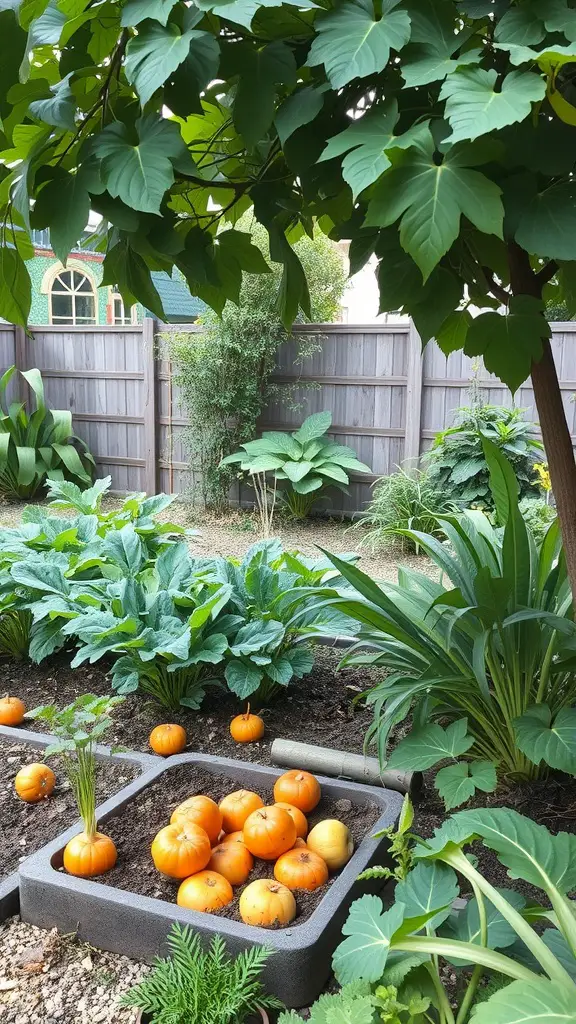
Creating a shade garden can be a fantastic way to grow cool-weather veggies. The image shows a vibrant garden filled with leafy greens and cheerful pumpkins, all thriving under the shelter of a tree. This setup not only protects the plants from harsh sunlight but also creates a cozy, inviting space.
In a shade garden, you can plant varieties like lettuce, spinach, and kale. These greens love the cooler temperatures and can flourish even with limited sunlight. The pumpkins in the image add a pop of color and are a fun addition, showing that you can mix different types of veggies.
Consider using raised beds, as seen in the image. They help with drainage and can make it easier to manage your plants. The surrounding foliage adds to the lush feel, creating a peaceful retreat right in your backyard.
Harvesting Techniques for Maximum Yield
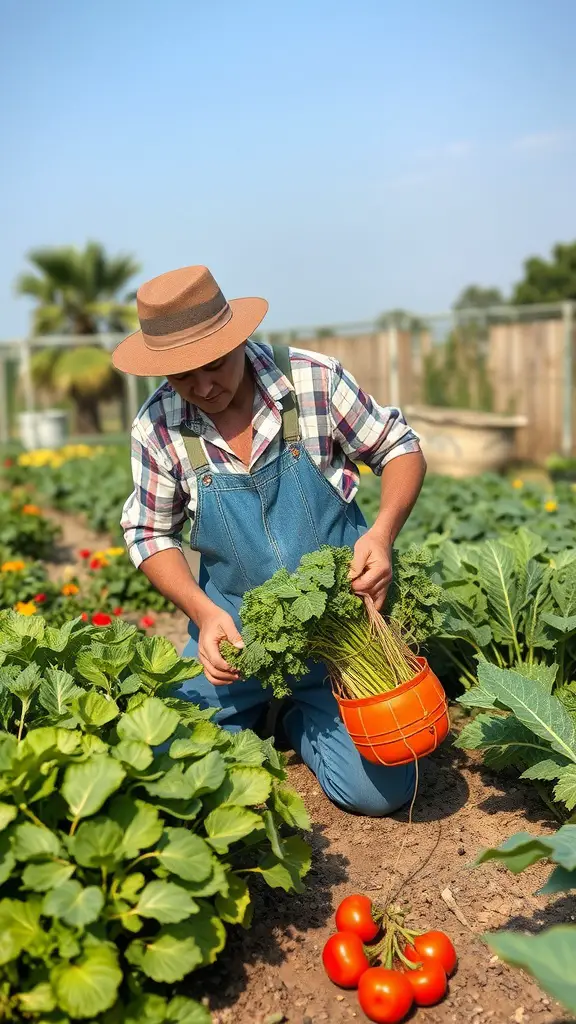
Harvesting is a key part of gardening that can make or break your yield. In the image, we see a gardener in overalls, carefully picking fresh vegetables. This hands-on approach is essential for getting the most out of your veggie garden.
Timing is everything when it comes to harvesting. Picking vegetables at their peak ripeness ensures the best flavor and nutrition. For example, tomatoes should be harvested when they are fully colored and slightly soft to the touch.
Using the right tools can also help. A simple basket, like the one in the image, makes it easy to collect your harvest without damaging the plants. Always handle your vegetables gently to avoid bruising.
Another technique is to harvest in the morning when temperatures are cooler. This helps preserve the freshness of your veggies. Plus, it’s a great way to start your day in the garden!
Lastly, don’t forget to check for any pests or diseases while you’re out there. Keeping an eye on your plants can help you catch issues early and maintain a healthy garden.
Sustainable Pest Management Solutions
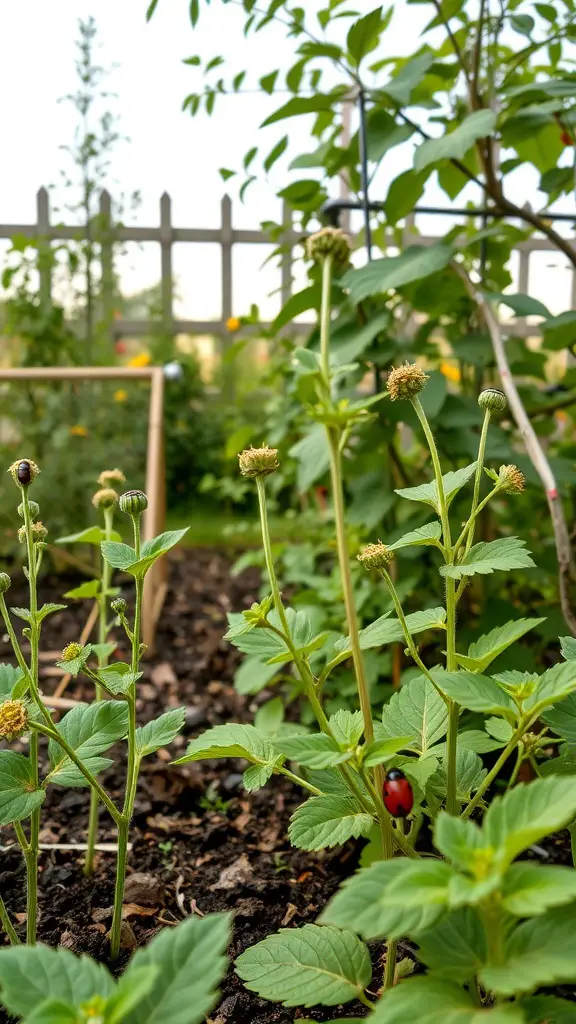
In a veggie garden, keeping pests at bay is essential for a healthy harvest. The image shows a vibrant garden with various plants, hinting at the importance of biodiversity. This diversity can naturally attract beneficial insects, like ladybugs, which help control pest populations.
One effective method is companion planting. For example, planting marigolds alongside vegetables can deter harmful pests. These flowers release compounds that repel insects, making your garden less appealing to them.
Another approach is using natural repellents. Simple mixtures of water and garlic or chili can be sprayed on plants to keep pests away. These solutions are safe for the environment and won’t harm your plants.
Regular monitoring is key. Check your plants often for signs of pests. Early detection makes it easier to manage any issues before they escalate. Hand-picking larger pests can also be effective and is a great way to engage with your garden.
Creating a balanced ecosystem in your garden not only helps manage pests but also promotes overall plant health. By using these sustainable methods, you can enjoy a thriving veggie garden without relying on harsh chemicals.
Planter Boxes for Urban Gardening
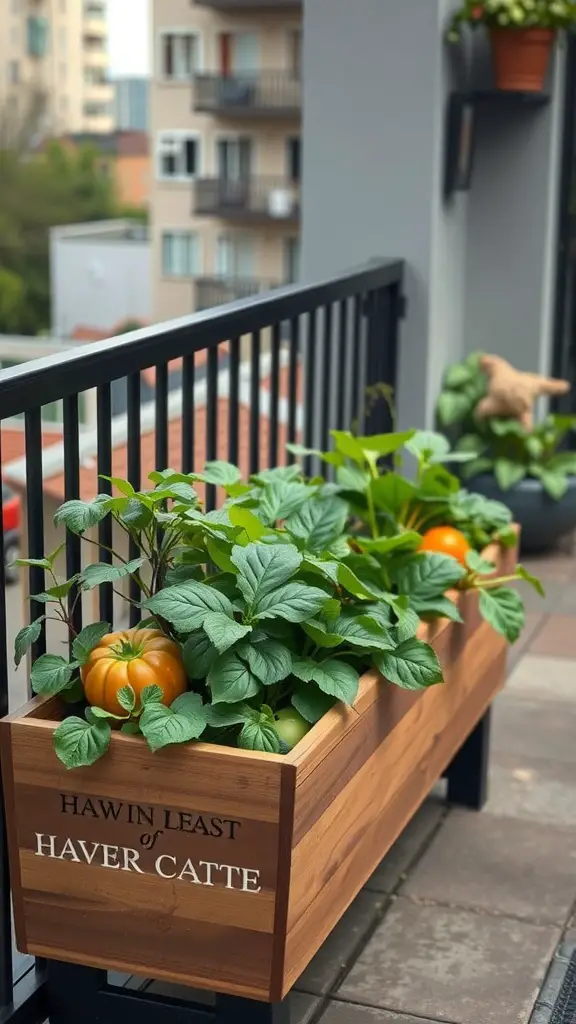
Planter boxes are a fantastic solution for urban gardening. They allow you to grow your favorite veggies even in limited spaces. The image shows a lovely wooden planter box filled with vibrant green plants and some ripe tomatoes. This setup is perfect for a balcony or patio.
Using planter boxes can make gardening more accessible and enjoyable. They can be placed on balconies, rooftops, or small yards. The elevated design makes it easier to tend to your plants without bending over too much. Plus, they can add a touch of nature to your urban environment.
When choosing a planter box, consider the materials. Wood is a popular choice for its natural look and durability. The one in the image has a beautiful finish that complements the greenery. Make sure to select a size that fits your space and allows for proper drainage.
Growing your own vegetables can be rewarding. You can start with easy-to-grow options like tomatoes, peppers, or herbs. With a little care, your planter box can become a mini garden that brings fresh produce right to your home.
Creating a Fruit and Vegetable Combo Garden
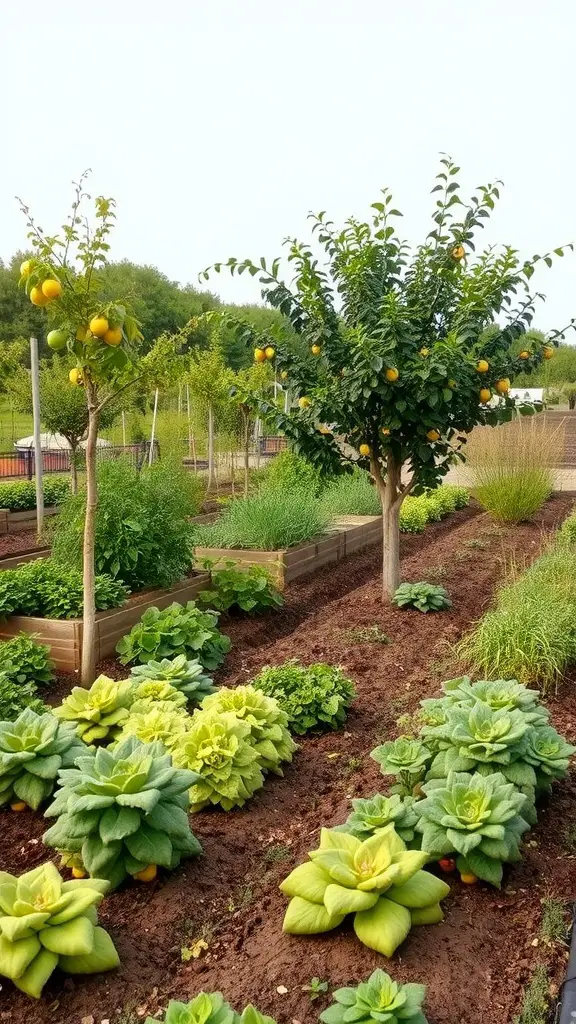
A fruit and vegetable combo garden can be a delightful addition to your outdoor space. The image shows a vibrant garden filled with lush greenery and fruit-bearing trees. You can see a variety of leafy vegetables growing alongside citrus trees, creating a beautiful and productive environment. This setup not only maximizes space but also enhances biodiversity, attracting beneficial insects that can help with pollination and pest control.
Planting fruits and vegetables together allows for a more efficient use of resources. For instance, the trees provide shade for some plants that prefer cooler conditions, while the vegetables can benefit from the nutrients in the soil. It’s a win-win!
When planning your garden, think about the types of fruits and vegetables that grow well together. Some great combinations include tomatoes with basil or strawberries with spinach. This not only makes for a visually appealing garden but also supports healthy growth.
Don’t forget to consider the layout. Raised beds can help organize your plants and make maintenance easier. Plus, they look neat and tidy! With a little planning, your combo garden can be both functional and beautiful, giving you fresh produce right from your backyard.
Using Hydroponics for Indoor Veggies
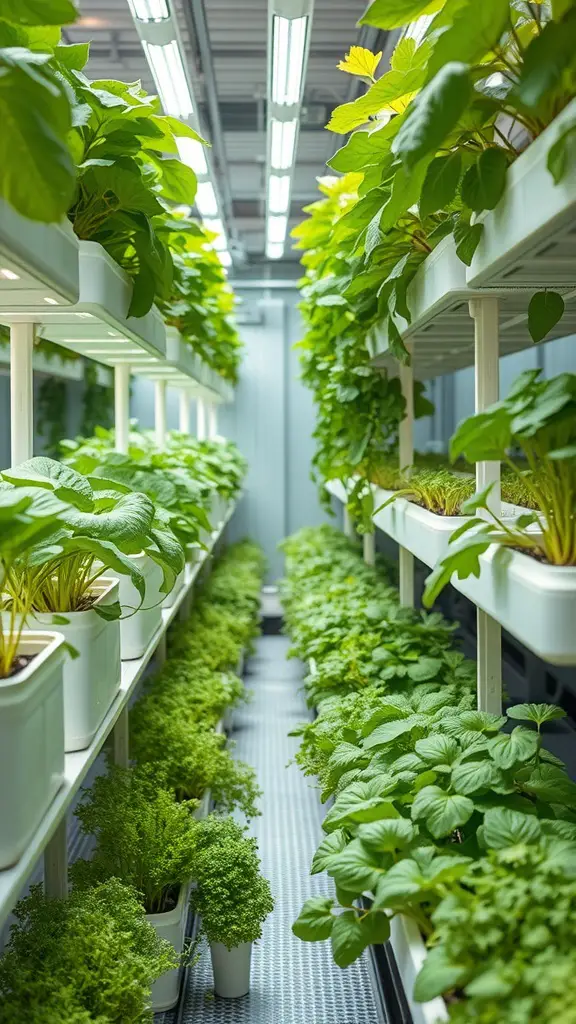
Hydroponics is a fantastic way to grow vegetables indoors, and the image shows a vibrant setup that highlights this method. The rows of healthy plants, thriving under bright lights, demonstrate how effective hydroponics can be in a controlled environment.
In this setup, you can see various leafy greens and herbs, all neatly arranged in pots. This organization not only maximizes space but also makes it easy to care for each plant. With hydroponics, you don’t need soil; instead, plants get nutrients directly from a water solution. This method can lead to faster growth and higher yields.
Indoor gardening with hydroponics is perfect for those with limited outdoor space. You can grow fresh veggies right in your kitchen or living room. Plus, it’s fun to watch your plants grow and know you’re providing your family with healthy food.
If you’re thinking about starting your own hydroponic garden, consider what veggies you want to grow. Leafy greens like lettuce, spinach, and herbs like basil and mint are great choices for beginners. With a little research and some basic equipment, you can create your own indoor veggie paradise!

